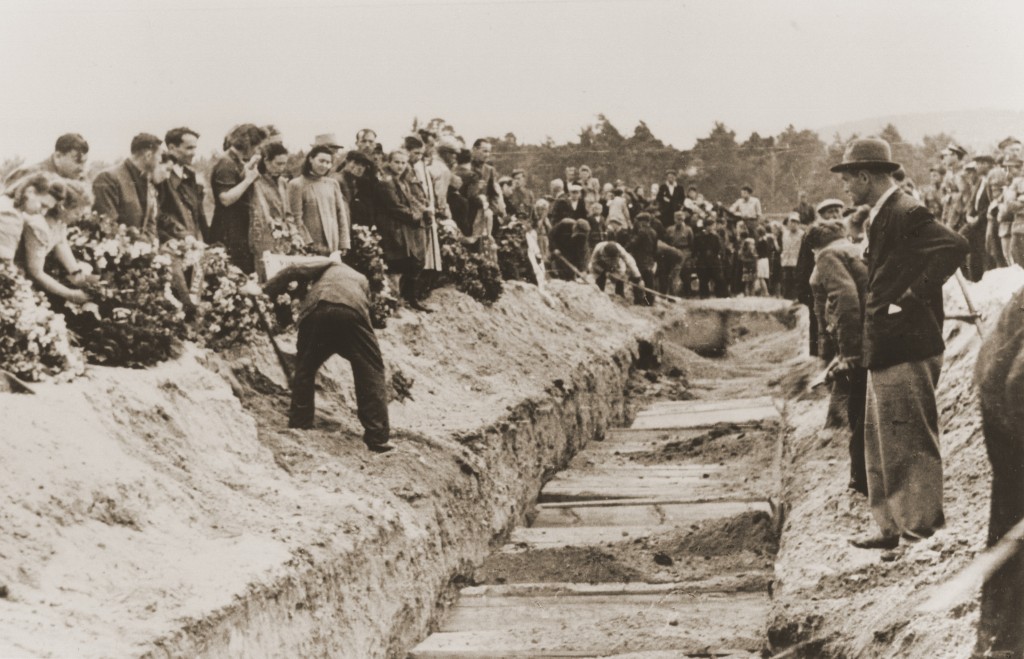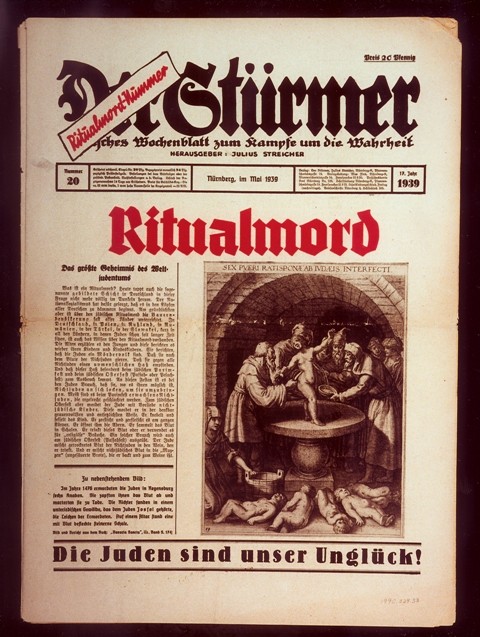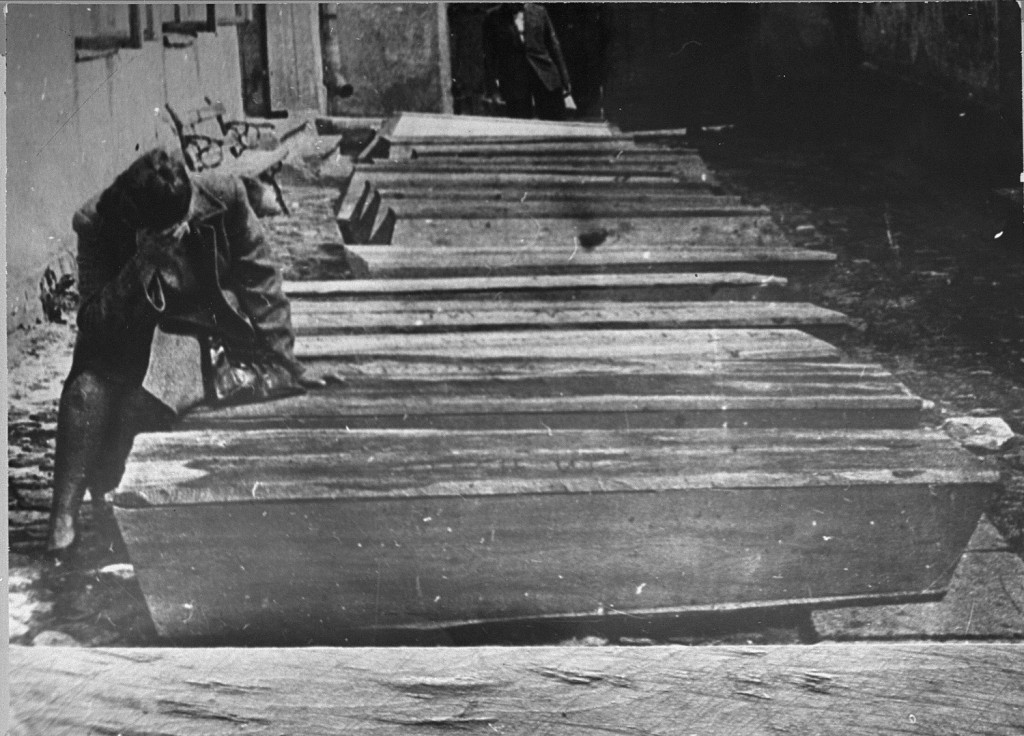
Blood Libel
The term blood libel refers to the false allegation that Jews used the blood of non-Jewish, usually Christian children, for ritual purposes. The Nazis made effective use of the blood libel to demonize Jews, with Julius Steicher's newspaper Der Stürmer making frequent use of ritual murder imagery in its antisemitic propaganda.
Blood Libels throughout History
Historically, blood libels often took place close to Passover, when Jews were charged with using the blood of Christian children to bake matzahs. The proximity of such charges to Easter was thus also often associated with the continuing belief that Jews were responsible for the Passion and Crucifixion of Jesus. Blood libels, together with allegations of well poisoning, were a major theme in Jewish persecution in Europe throughout the Middle Ages and into the modern period. They were a central component in the development of modern antisemitism in the 19th century.
Blood libel accusations often led to pogroms, violent riots launched against Jews and frequently encouraged by government authorities.
Murder is expressly forbidden in the Torah, as are the blood sacrifices which were practiced by ancient pagan religions. In fact, Jewish dietary laws (kashrut), forbid the consumption of blood in food and require all blood to be drained from slaughtered animals before consumption.
Blood Libels in the Middle Ages
The earliest references to blood libel charges against the Jews can be found in the Hellenistic writings of Apion in the 2nd century BCE. However, the spread of Christianity in western Europe saw the growth of the blood libel myth, in particular in the 12th century in the aftermath of the First Crusade.
The first case of the blood libel in Europe in the Middle Ages was that of William of Norwich in 1144. The Jews of Norwich, England, were charged with ritual murder after the body of a young boy (William) was discovered stabbed to death in the woods. In this case, the Jews of Norwich were alleged to have "bought a Christian child [the 'boy-martyr' William] before Easter and tortured him with all the tortures wherewith our Lord was tortured, and on Long Friday hanged him on a rood in hatred of our Lord."
Subsequent cases were recorded in Gloucester, England (1168); Blois, France (1171); Saragossa, Spain (1182); Bristol, England (1183); Fulda, Germany (1235); Lincoln, England (1255); and Munich, Germany (1286). Medieval poet Geoffrey Chaucer's "The Prioress's Tale" (in The Canterbury Tales) also invokes the blood libel motif, describing Jews as aroused by satanic urges to murder Christian children.
The motif of the Jewish need for Christian blood spread throughout the Middle Ages. It was combined with allegations of well-poisoning by Jews during the time of the Black Death in the middle of the 14th century. By the 15th century, the motif was commonplace throughout western and central Europe. It often gave rise to legends around miracles performed by the alleged victims of the blood libels. In 1475, a 2-year old boy named Simon disappeared from the city of Trent in Italy around the time of Easter. His father alleged that he had been kidnapped and murdered by the local Jewish community in order to make matzah for Passover. The entire Jewish community was arrested and forced to confess under torture before they were sentenced to death and burned at the stake. After hundreds of miracles were ascribed to Simon of Trent, a religious cult spread across Italy, Germany, and Austria in his name and he was granted sainthood in the 16th century (subsequently removed by the pope in 1965).
Blood Libels in the 16th to 19th Centuries
Martin Luther, German theologian and key figure in the Protestant Reformation, lent even further credence to the blood libel charge by accepting the Jewish use of Christian blood as fact in his On the Jews and their Lies (published in 1543).
By the 17th century, blood libels became increasingly common in eastern Europe, particularly in Poland and Lithuania. Jews had moved to Poland from the German lands during the Middle Ages in return for the promise of protection by Polish nobles. But as conditions deteriorated for the Jews in Poland, blood libel cases spread. In 1690, a six-year old boy named Gavriil Belostoksky was kidnapped from his home in Zverki in the Commonwealth of Poland-Lithuania; a Jew named Shutko was accused of murdering the child in Bialystok and the boy became a saint in the Russian Orthodox church.
Blood libel charges in eastern Europe often resulted in the outbreak of pogroms, or anti-Jewish riots. The 1903 Kishinev pogrom started with the murder of a Christian boy in the town of Dubossary, about 15 miles (25 km) north of Kishinev, the capital of Bessarabia in the Russian Empire. Spurred by articles published in the Russian-language antisemitic newspaper The Bessarabian, the pogrom broke out on April 19, 1903 (Easter Sunday). In the course of three days of rioting, almost 50 Jews were killed and hundreds were wounded. Hundreds of Jewish homes and businesses were looted and destroyed.
The Beilis Affair, in which Menachem Mendel Beilis was accused of murdering a Christian boy in 1911 (and subsequently acquitted at a trial in 1913), sparked international criticism of Czarist Russia's antisemitic policies.
Blood libel charges also spread beyond Europe in the 19th century. The 1840 Damascus Affair and the 1910 Shiraz (Iran) blood libel marked the spread of the blood libel charge in the Arab world.
Blood Libels in the Nazi Era and after the Holocaust

The Nazis made effective use of the blood libel charge in their antisemitic propaganda. In 1923, Julius Streicher established his virulently antisemitic newspaper, Der Stürmer (The Attacker), which frequently employed the blood libel motif. The May 1934 volume of Der Stuermer was devoted specifically to the blood libel, accusing Jews of practicing ritual murder to secure the blood of Christians to use in Jewish religious rituals with the headline “Jewish Murder Plan against Gentile Humanity Revealed.”
Even after the Holocaust, the blood libel charge figured prominently in a number of pogroms that broke out in Poland after the war. Most prominent was the Kielce pogrom of July 1946. The pogrom was sparked by charges that a nine-year-old non-Jewish boy, Henryk Blaszczyk, who had left his home in Kielce without informing his parents, had been kidnapped and hidden in the basement of the local Jewish Committee building in Kielce. Although he returned home two days later, the accusation led to a pogrom that resulted in the deaths of 42 Jews and sparked the widespread flights of thousands of Jews out of Poland once and for all.

The Roman Catholic Church has repudiated the blood libel charge, removing Simon of Trent from the list of saints in 1965. Nonetheless, the myth of the blood libel remains powerful into the 21st century. A 2003 TV series broadcast in Syria and Lebanon based on The Protocols of the Elders of Zion shows the Jewish people as engaging in a conspiracy to rule the world, and presents Jews as a people who murder Christian children and drain their blood to bake matzah.
Critical Thinking Questions
- How did Nazi antisemitism build on previous beliefs and attitudes?
- Why do people generalize characteristics for an entire group? How can this be dangerous?
- How can deep-seated hatreds be countered?
- How can knowledge of the events in Germany and Europe before the Nazis came to power help citizens today respond to threats of genocide and mass atrocity in the world?

